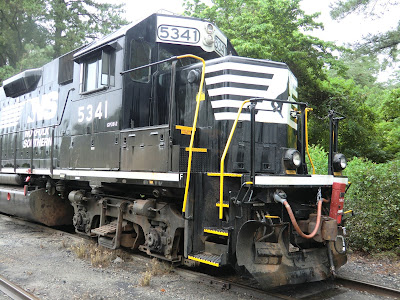Not good. I quickly did some mock ups on top of my wife's sewing layout table to get to a simulated 42" deck height. Then, using her small step stool, I determined that I could get away with a 36" maximum reach, although I knew that was against a LOT of recommendations. I grabbed a scale and started looking at my break through layout - DISASTER!!! I have major reach issues in two locations. The layout would be against the wall on the top and left sides. No way this is ever going to work. Just when I thought I was nearly close to developing the plan and cutting some lumber.
Here' the reach dead zones:
Well, as the title says, lurking is learning.
Speaking of mock ups, when I was conducting my little reach simulation my wife was observing and asked, "So how big is your layout going to be?" One of the must haves for our new home was a train room and the FROG is all mine. In addition to the layout, I also have my desk, a couple of rolling file cabinets (mostly hobby supplies), my hobby table and a bookshelf (train books) in the room. All that means that I really don't have as much floor area as the entire 13'-6" x 14'-8" space. I had always figured about 10'-6" max width (which still affords access to the room's closet) and about 8' max on one leg with 9'-10' max on the other leg of a U-Shaped layout. I really loved what Steve Miazga did with his Missabe Junction layout (see November 2013 Model Railroader) and foolishly thought I could change his 12" grid to a 9" grid, tighten the curves and make it work for me. I had just sketched out the footprint of the benchwork outline when my wife asked me that question. Here's Steve's layout:
With her help, we grabbed some of our empty Christmas decoration boxes and proceeded to basically mock up, at 1:1 scale, what I had envisioned as my layout area. Well guess what - way too big, way too claustrophobic and would leave me with no real way to do anything other than squeeze past a layout. As the saying goes - back to the drawing board.
A long rambling post directed at two groups: 1. To all you lurkers out there - keep lurking, reading and learning. It sinks in and it really pays off. 2. To all the really great folks out there who have provided input and their expertise - THANK YOU!!! Folks like WP&P, ChicagoNW, OTFan & countless others, y'all are helping a lot of newbies like me learn and avoid costly mistakes.
When I posted this on N Scale Net, a couple of the folks mentioned above pointed out that without posting, or getting feedback, there's not a lot of learning. Great point. Sure you have to be receptive to constructive criticism (I'm an architect - we live by it) and I've never received a snide or condescending reply to anything I've ever posted on that site.
Back to the drawing board working with a reduced footprint and more of a L Shape.
























































